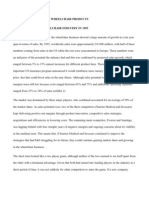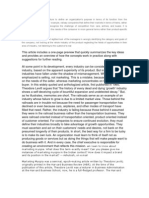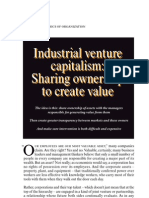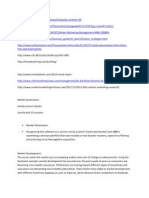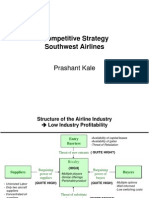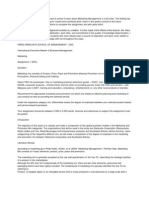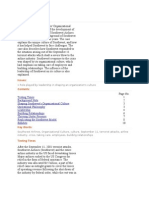From Market Driven To Market Driving: Nirmalya Kumar, Lisa Scheer, Philip Kotler
From Market Driven To Market Driving: Nirmalya Kumar, Lisa Scheer, Philip Kotler
Uploaded by
Hana OthmaniCopyright:
Available Formats
From Market Driven To Market Driving: Nirmalya Kumar, Lisa Scheer, Philip Kotler
From Market Driven To Market Driving: Nirmalya Kumar, Lisa Scheer, Philip Kotler
Uploaded by
Hana OthmaniOriginal Title
Copyright
Available Formats
Share this document
Did you find this document useful?
Is this content inappropriate?
Copyright:
Available Formats
From Market Driven To Market Driving: Nirmalya Kumar, Lisa Scheer, Philip Kotler
From Market Driven To Market Driving: Nirmalya Kumar, Lisa Scheer, Philip Kotler
Uploaded by
Hana OthmaniCopyright:
Available Formats
European Management Journal Vol. 18, No. 2, pp.
129–142, 2000
Pergamon 2000 Elsevier Science Ltd. All rights reserved
Printed in Great Britain
PII: S0263-2373(99)00084-5 0263-2373/00 $20.00
From Market Driven to
Market Driving
NIRMALYA KUMAR, IMD, Lausanne
LISA SCHEER, University of Missouri, Columbia
PHILIP KOTLER, J.L. Kellogg Graduate School of Management, Northwestern University
Firms are constantly exhorted to become more mar- ket drivers, we can glean insights about the culti-
ket driven. However, our study of 25 pioneering vation of successful market driving innovations.
companies (e.g. Body Shop, IKEA, Tetra Pak) whose
success has been based on radical business inno-
Consider Aravind Eye Hospital of Southern India.1
vation indicates that such companies are better
In 1976, a 58 year old retired eye surgeon, Dr. Venkat-
described as market driving. While market driven
aswamy, devised a plan to serve the 15 million resi-
processes are excellent in generating incremental
dents of India who were blind as a result of cataracts.
innovation, they rarely produce the type of radical
Venkataswamy’s vision was to market cataract sur-
innovation which underlies market driving compa-
gery, a relatively straightforward operation, like
nies. Market driving companies, who are generally
McDonald’s hamburgers. Hospitals in India typically
new entrants into an industry, gain a more sus-
fell into one of two categories — private hospitals
tainable competitive advantage by delivering a leap
that served the small, wealthy segment of the popu-
in customer value through a unique business sys-
lation with state-of-the-art facilities or charitable hos-
tem. Market driving strategies entail high risk, but
pitals that served the poor, vast majority of the popu-
also offer a firm the potential to revolutionize an
lation with inadequate, out-dated, overcrowded
industry and reap vast rewards. Although estab-
facilities. In addition, most of the poor, who reside
lished companies face four major obstacles in
in the countryside, were unable to access most hospi-
developing and launching radical market driving
tals, which were usually located in urban areas.
business ideas, we offer several recommendations
to help established companies overcome these
obstacles and become more market driving. 2000 To implement his vision of giving eyesight to the
Elsevier Science Ltd. All rights reserved blind, regardless of ability to pay, Dr Venkataswamy
set up hospitals in South India that serve both the
rich, who pay for the state-of-the-art cataract surgery,
The value of being market driven is unquestioned in and the poor, who receive almost identical services
companies today. Current practice dictates that suc- for free. The salesforce, advertising, and promotion
cess starts with careful market research, investigating of Aravind Eye Hospital focus on attracting free
the customers’ needs, and developing differentiated rather than paying patients. For example, the sales
products or services for a well-defined segment. Vari- force has annual targets for the number of free
ous excellent companies such as Nestlé, Procter & patients they must generate; weekly ‘sales meetings’
Gamble, and Unilever effectively employ this market monitor individual performance towards these tar-
driven approach. However, many successful pion- gets. Aravind’s sophisticated salespeople scour the
eering companies, who have created new markets Indian countryside looking for poor patients within
and revolutionized existing industries through radical their assigned territories and then transport them to
business innovation like Amazon.com, Body Shop, the hospital at no cost to the patient. Think what cus-
CNN, IKEA, Starbucks, and Swatch, are better tomer satisfaction must be like among these poor
described as market driving. Although market driving patients who regain their ability to see — for free!
involves inherently high risk and many would-be By focusing on eyecare and routinizing procedures,
market drivers fail spectacularly, when market driv- Aravind’s surgeons are so productive that this non-
ing strategies are successfully devised and profit organization has a gross margin of 50 per cent
implemented they rewrite industry rules and offer despite the fact that over 65 per cent of the patients
the potential to reap vast rewards. By studying the served do not pay! And unlike most nonprofit
elements that contribute to the success of these mar- organizations in the developing world, it is not
European Management Journal Vol 18 No 2 April 2000 129
FROM MARKET DRIVEN TO MARKET DRIVING
dependent on donations and attempts to maximize a pleasant shopping atmosphere, and low prices,
the number of free patients served. while asking the consumer in return to engage in self-
service, self-assembly, and self-transportation, often
What Aravind Eye Hospital shares with other market from peripheral locations. This was a dramatically
driving firms such as Amazon.com, Benetton, Body different value proposition from the traditional, full
Shop, Charles Schwab, Club Med, CNN, Dell, FedEx, service, expensive, high street furniture store. As Fig-
Hennes and Mauritz, IKEA, SAP, Sony, Southwest ure 2 indicates, rather than playing on the existing
Airlines, Starbucks, Swatch, Tetra Pak, Virgin, and industry iso-value line, market driving firms such as
Wal-Mart is the inability of the market driven IKEA deliver a discontinuous leap in customer value.
approach to explain their success. These market driv-
ing firms did not use traditional market research to The leap in customer value provided by market driv-
devise their path-breaking strategies that challenge ing firms may involve either breakthrough tech-
the status quo. Market research, while useful in gener- nology or breakthrough marketing. The success of
ating incremental innovation, seldom leads to break- Body Shop, FedEx, Starbucks, and even CNN and
through innovations.2 The inspiration for the radical Wal-Mart is less about new technology than about
business ideas of these market driving firms came aggressively exploiting existing technology to see the
from a visionary such as Dr Venkataswamy, Anita marketplace differently and to serve the customer in
Roddick of Body Shop, or Richard Branson of Virgin an unconventional manner. The key to the success
who saw the world differently and whose vision of these market driving firms is that they create and
addressed some deep-seated, latent, or emerging deliver a leap in benefits, while reducing the sacri-
need of the customer. Rather than focusing on fices and compromises that customers make to
obtaining market share in existing markets, these receive those benefits (e.g. having to organize your
market drivers created new markets (e.g. CNN, Fed- schedule around when the networks wish to broad-
eral Express, SAP, Tetra Pak) or redefined the cate- cast the news) (Stalk et al., 1996). They create a
gory in such a fundamental way that competitors product/service experience that overwhelms cus-
were rendered obsolete (e.g. none of the top 10 dis- tomer expectations and existing alternatives. As a
counters of 1962, the year Wal-Mart was born, are in result, the landscape of the industry is substantially
business today).3 Ultimately, these firm revol- altered.
utionized their industries by changing the rules of the
game and ‘driving’ their markets. Business system refers to the configuration of the
various activities required to create, produce, and
Our research indicates that the success of market deliver the value proposition to the customer. IKEA
driving firms is based in radical innovation on two could not deliver its discontinuous value proposition
dimensions — a discontinuous leap in the value by just improving on the existing business system of
proposition and the implementation of a unique busi- the traditional furniture store (see Figure 3).5
ness system (see Figure 1).4 Value proposition refers
to the combination of benefits, acquisition efforts/costs, Traditional furniture channels were beset by expens-
and price offered to customers. For example, IKEA ive independent designers, high work-in-progress
offers the benefits of clean Scandinavian design and inventory, labor intensive handicraft manufacturing,
image, tremendous assortment, immediate delivery,
Figure 1 Types of Strategic Innovation Figure 2 Leap in Customer Value
130 European Management Journal Vol 18 No 2 April 2000
FROM MARKET DRIVEN TO MARKET DRIVING
Figure 3 Unique Business System
considerable transportation and inventory of finished turing systems and unhappy, bypassed channel
goods, fragmented marketing, costly high street retail members. In the absence of a unique business system,
locations, elaborate displays, and expensive delivery any advantage gained from a discontinuous leap in
to the consumer. To deliver the discontinuous leap the value proposition can be copied fairly quickly by
in customer value, IKEA had to radically reconfigure existing players. Therefore, market driving firms who
the industry business system. IKEA’s unique busi- change the rules of the game are those that innovate
ness system uses cost-conscious in-house design, on both dimensions of Figure 1. The unique business
interchangeable parts, high volume component system creates a more sustainable advantage, as it
manufacturing, parts inventory (rather than more takes time for a would-be competitor to assemble the
expensive finished product inventory), extensive intraorganizational and interorganizational players
computerization of logistics, its natural Scandinavian needed to replicate that unique system architecture.
image, relatively inexpensive peripheral locations,
and simple display facilities, leaving final transpor- We describe these firms as market driving for three
tation and assembly to the consumer. To profitably reasons. First, market driving companies trigger
copy IKEA’s value proposition, firms in the tra- industry breakpoints or what Andy Grove of Intel
ditional furniture channel would need to dismantle calls ‘strategic inflexion points’ which change the fun-
the existing business system while migrating to a damentals of the industry through radical business
new IKEA type business system — a Herculean innovation. Second, instead of being inspired by tra-
task indeed! ditional market research as conventional wisdom rec-
ommends, the inspiration for their radical business
Because the value proposition is visible in the mar- concept usually comes from a visionary. Third, rather
ketplace while the business system is harder to dis- than learn from existing customers, they often have
cern, competitors often miss the importance of the to teach potential customers to consume their discon-
latter. For example, Dell delivers built-to-order cus- tinuous value proposition.
tomized PCs which incorporate the latest technologi-
cal advances faster than its competitors and at The plan of the paper is as follows. First, we contrast
reasonable prices. To deliver this value proposition, market driving with three other possible orientations
Dell invented a radically different business system that a firm can have towards the marketplace. We
combining minimal R&D expenditures, made-to- describe how market driving firms compete and seize
order flexible manufacturing systems (which give advantage. Then, we discuss why most market driv-
them a slight manufacturing cost disadvantage), one ing companies are new entrants to an industry and
week of inventory consisting mostly of parts, mini- explore the barriers and risks that large, established
mal end-user advertising, and efficient direct distri- firms face in successfully developing and launching
bution channels. In contrast, Dell’s primary competi- radical market driving innovations. Finally, we con-
tors, Compaq and IBM, have high R&D expenditures, clude with some recommendations for how estab-
large run low variety (but low cost) manufacturing lished companies can become more market driving.
systems, one month of mostly finished goods inven-
tory, extensive end-user advertising, and expensive
third-party distribution channels. When Compaq and
IBM tried to copy Dell’s value proposition by setting
How Market Driving Firms Seize
up their own direct channels, their existing business Advantage
systems proved too ‘sticky’ to do so profitably. It is
difficult to deliver customized products at competi- Market driving can be distinguished from three other
tive prices with high volume, low variety manufac- orientations that a company can have towards the
European Management Journal Vol 18 No 2 April 2000 131
FROM MARKET DRIVEN TO MARKET DRIVING
marketplace: sales driven, market driven, and cus- ary products, concepts, and technologies. Consider
tomer driven. These four categories represent ideal the experience of Swatch. The Swatch models that
types; no large organization adopts a single orien- received the highest intention to purchase in con-
tation throughout all of its business units. A sales sumer research were those that looked the most like
driven orientation characterizes those firms who traditional watches. Those watches, however, ulti-
view marketing as a tool to sell whatever their fac- mately generated very few sales. Instead, the more
tory produces. Marketing and selling are inter- radically different Swatch models, which were rated
changeable in such companies.6 Public utilities, mon- in traditional prelaunch consumer research as the
opolies and some large manufacturing firms often least likely to be bought, were subsequently the best
display a sales orientation. Market driven companies selling ones. Had Swatch been guided by that market
instead place the customers at the start of the process research, it would not have been a runaway success.
and through careful market research build appropri- Similarly, customers weren’t clamoring for Starbucks
ate products for, and develop the desired image for, coffee, CNN, or overnight small package delivery
their target segments. Most successful consumer prior to their introduction.
packaged goods companies such as L’Oreal fall in
this category. Customer driven companies, on the Market driving firms instead coalesce around vision-
other hand, target ‘segments of one’ and deliver cus- aries who saw opportunity where others did not —
tomized value configurations to each customer. This an opportunity to fill latent, unmet needs or to offer
is sometimes referred to as relationship marketing. an unprecedented level of customer value. In our
The Swiss private banking industry, which serves research we discovered that generation and develop-
high net worth individuals, is populated with several ment of ‘the idea’ was a combination of serendipity,
such customer driven firms. Table 1 outlines and inexperience, and persistence. For example, Star-
summarizes the key distinctions between these four bucks was founded in 1983 after Howard Schultz,
marketplace orientations on various elements of mar- charmed by the Italian coffee culture of Verona and
keting strategy. Milan, promised to bring it to America. Frequently,
visionaries’ relative inexperience with the industry
Given the focus of this paper, we concentrate on how meant they had not yet been inoculated with that
the market driving firm competes. Our in-depth industry’s received wisdom. Nike’s Bowerman was
study of 25 market driving firms indicates that they a college track coach, Club Med’s Gerard Blitz was a
share certain common features as described below. diamond cutter, and Ingvar Kamprad, the founder of
IKEA, began his entrepreneurial career selling fish.
Often, these visionaries persisted in the face of many
Guided by Vision Rather Than Traditional failures and rejections to realize the dream such as
Market Research Fred Smith of FedEx who developed the guaranteed
overnight delivery idea in a business school term
Consumers and organization buyers are excellent at paper as a junior at Yale. He received a ‘C’ for the
motivating and evaluating incremental innovation. paper because the instructor was not convinced
However, customers are usually unable to concep- about its practicality!7 Some spent years muddling
tualize or readily visualize the benefits of revolution- through refining their vision until everything clicked
Table 1 Four Orientations to Marketplace
Sales driven Market driven Customer driven Market driving
Marketing strategy Mass marketing (how to Differentiated marketing Relationship marketing Revolutionary marketing
sell?) (what image to build?) (who to serve?) (how to change the rules
of the game?)
Segmentation strategy Undifferentiated Market segments Segments of one Destroy industry
segmentation
Market research
‘Focus’ Market testing (how to Market sensing (what Customer sensing (what Forward sensing (how
sell it?) does the market want?) does this customer can the marketplace
want?) evolve)
‘Listen to’ R&D Voice of the market Voice of the customer Seeing differently
Price management Cost plus Perceived value Bundling/unbundling New price points
Sales management Sell products Sell image Sell solutions Customer education
Channel management Maximum coverage Product/market fit Multiplex systems Channel reconfiguration
Brand management Product superiority Broadcast for brand Dialogue for corporate Exploit ‘buzz network’
equity equity
Customer service Expense Tactical weapon Strategic weapon Overwhelm expectations
Product development New products Incremental innovation Integrating Radical innovation
product/service platforms
132 European Management Journal Vol 18 No 2 April 2000
FROM MARKET DRIVEN TO MARKET DRIVING
and they perfected their strategies. Wal-Mart’s initial service offering and marketing strategy. This creates
attempts were underwhelming. David Glass, today havoc in the industry by destroying the segmentation
the CEO of Wal-Mart was at that time employed with followed by the industry prior to the market driver’s
a competing store; he reportedly opined after check- entry and replacing it with a new set of segments
ing out the first Discount City, ‘Those guys will never reflecting the new, altered landscape:
make it.’ Sam Walton continued to tinker with the
formula until he got it right. Few of these visionaries ❖ Aravind Eye Hospital did not accept the normal
expected that their business idea would achieve the segmentation between rich and poor patients.
level of success that was ultimately attained. As ❖ Southwest Airlines destroyed the segmentation
Hasso Plattner, the co-founder of SAP, observed: between ground transportation and airlines,
‘When people ask how we planned all this, we attracting many who would not otherwise have
answer “we didn’t. It just happened”’(Plattner, 1996). flown at all.
Even when industries are revolutionized, the market
driver may not be profitable or successful in the long ❖ Swatch, with its cheap and fashionable watches,
term. For example, Amazon.com has dramatically bridged the chasm between the segments for
altered the landscape in the marketing of books, forc- cheap, utilitarian watches and expensive, fashion-
ing industry leaders like Barnes and Noble to venture able ones.
into e-tailing, even though Amazon has yet to come ❖ Wal-Mart demonstrated that small rural towns
near an operating profit. could support huge discount stores which pre-
viously had located only in large urban areas.
Because they are trying to change the rules of the ❖ While existing software vendors concentrated on
game and face many obstacles on the way to success, developing different software packages for differ-
market driving companies recruit and select people ent departments (e.g. manufacturing, sales,
who subscribe to the values of the organization. human resources), SAP destroyed these distinc-
There is often an attempt to attract those with little tions by developing enterprise software that could
experience in the industry, individuals who have not integrate and run the entire business.
been infused with the industry’s conventional wis-
dom about why the market driving idea is doomed to
fail. Such employees are motivated strongly by their
belief that they are on a mission, not simply by Value Creation Through New Price Points
money, allowing them to tap into deeper motiv-
To deliver a leap in customer value, market driving
ational energies. A compelling vision enthusiastically
firms establish new industry price points for the qual-
articulated by a charismatic leader turns these
ity or service levels they deliver. Swatch, Aravind
employees into crusaders:
Eye Hospital, Southwest Airlines, and Charles
Schwab all set prices much lower than those pre-
❖ Sam Walton believed that Wal-Mart stores would viously available for similar products. This puts exist-
‘lower the cost of living for everyone, not just ing competitors under tremendous pressure. The
America... we’ll give the world an opportunity to competitors must make dramatic changes in oper-
see what it’s like to save and have a better lifestyle, ations and product lines to survive, but they are
a better life for all’ energized his employees. unable to swiftly meet the challenge because they
❖ Ninety per cent of Body Shop franchisees are cannot quickly and successfully reproduce the innov-
women who have no formal business training but ative business system that enables the lower price
are instead chosen on the basis of personality tests, point. Continental learned this the hard way when
home visits, and attitudes towards the environ- it tried to compete against Southwest Airlines with
ment and people. They are motivated by founder ‘Continental Lite’:
Anita Roddick’s idea that they can make a differ-
ence in people’s lives and in the world through ❖ When Southwest Airlines enters a new city they
Body Shop. price against ground transportation as much as
❖ In the early days at FedEx, there were couriers against existing air service. This typically results
who pawned their watches to pay for gasoline. in prices at least 60 per cent below competitive
airfares — sometimes over 75 per cent lower. For
Such historic, sometimes mythic, stories become part example, Southwest Airlines charged $15.00 for a
of the organizational culture of most market driv- trip from Dallas to San Antonio when Braniff, the
ing firms. next most inexpensive competitor, was charging
$62.00. A shareholder asked the CEO, ‘Could you
not raise the price two or three dollars?’ and
Re-draw Industry Segmentation received the response, ‘We are not competing
against other airlines but ground transportation.’
By attracting their customers from a variety of pre- ❖ Swatch adopted a simple introductory pricing
viously-defined market segments, a new market strategy — $40 in United States, 50 CHF in Switz-
coalesces around the market driving firm’s product- erland, 60 DM in Germany, and 7000 yen in
European Management Journal Vol 18 No 2 April 2000 133
FROM MARKET DRIVEN TO MARKET DRIVING
Japan — and kept those prices unchanged for the Boeing 737s, reducing the costs of maintenance
first 10 years despite high demand. and pilot training. Furthermore, Southwest Air-
lines does all of its own ticketing and does not
While the trend is towards higher performance at make seats available through the standard indus-
lower price points, there are market driving firms try computerized reservation systems like Sabre
who have established elevated price points that are and Apollo. As a result, only 55 per cent of
higher than typical in an industry. CNN, Starbucks, Southwest’s tickets are sold through travel agents
and FedEx set prices considerably above what cus- compared to 90 per cent for the industry, adding
tomers had been paying. Inducing the buyer to pay up to substantial savings on travel agents’ com-
these higher prices requires that these market driving missions.
firms have a value proposition that is significantly ❖ Benneton has set up a unique system where they
more compelling than the available alternatives. subcontract simple, non-essential tasks. Only cru-
cial quality-maintenance tasks such as dyeing are
done in-house. Furthermore, by knitting products
Sales Growth Through Customer Education prior to dyeing rather than vice versa they can
respond faster to sales data than the rest of the
Given the radical new concept, the sales task for mar- industry.
ket driving firms is not to sell but rather to educate ❖ Wal-Mart revolutionized manufacturer–retailer
the customer on the existence of, and how to con- relationships by ‘forcing’ Procter & Gamble as
sume, their radical value proposition: well as its other suppliers to rationalize their pro-
duct lines, adopt Everyday Low Prices, eliminate
❖ Aravind Eye Hospital has to continuously educate wholesalers, present one invoice per company,
its ‘free’ patients, who are predominantly illiterate, and establish electronic links with their stores
that their vision can in fact be restored and that (Kumar, 1996). This helped eliminate considerable
the necessary surgery is available to them free of costs in the value chain.
charge.
❖ IKEA had to teach consumers the benefits of trans-
porting furniture components home for self- Brand Attachment by Capitalizing on the ‘Buzz
assembly instead of buying it pre-assembled and Network’
delivered. When IKEA entered Switzerland, they
ran advertisements which joked about the Swiss Market driving firms often place greater reliance on
unwillingness to transport and assemble furniture, the ‘buzz network’ to get their message across.
even for lower prices. The advertisements poked Because these firms offer a leap in customer value,
fun at the self-delivery and self-assembly aspects their customers are delighted and eager to notify
saying ‘That is a stupid thing’ and ‘You can’t do others about their ‘find.’ Reporters in trade publi-
that to the Swiss.’ cations and the popular press also often publicize the
radical new innovation. The commitment and
enthusiasm of early adopters and opinion leaders
generates excitement and an intangible brand cachet
Channel Reconfiguration
that the market driving firm strives to maintain.
In almost every market driving firm, channel recon- Consequently, market drivers don’t find it as neces-
figuration appears to play a critical role in generating sary to spend a lot of money on traditional advertis-
the architectural innovation that results in a unique ing; their advertising-to-sales ratio is often less than
business system. Market driving firms have unle- that of their established competitors:
ashed a wide range of innovative distribution and
channel management practices within their indus- ❖ Benetton is a classic example of a market driving
tries: firm leveraging its controversial advertising to
generate loads of free publicity and develop an
❖ FedEx transported packages using its own planes image which arouses strong feelings among both
via a ‘hub and spokes’ air freight system rather those who love and those who hate them.
than the ‘point-to-point’ commercial flights used ❖ Southwest Airlines boasts ‘We have a lot of
by competitors such as Emery. The result was that ambassadors out there, our Customers.’ Every
FedEx was twice as likely as Emery to deliver a year representatives from dozens of cities beg
package on time. Southwest to launch services in their cities.
❖ On the other hand, Southwest Airlines does not ❖ A 1958 13-page Life magazine photo spread on
employ the hub and spoke system used by the rest Club Med led to many more customers than
of the passenger airline industry, but rather con- capacity. In 1962, 12 years after the first village,
centrates on point-to-point short haul flights. they turned away more than a 100,000 applicants
Southwest flies into major cities’ less congested as they could only accommodate 70,000 members.
smaller airports which improves their on-time per- ❖ Nike didn’t run a single national television ad
formance vis-à-vis major carriers. They used only until they had 1 billion dollars in sales. Phil Knight
134 European Management Journal Vol 18 No 2 April 2000
FROM MARKET DRIVEN TO MARKET DRIVING
observes they instead ‘used word-of-foot advertis- their head, market driving companies are usually
ing’ by getting the best athletes to wear their pro- new entrants to the industry.9 Often, the market driv-
ducts. ing ideas were available to, but rejected by, incum-
❖ Virgin’s Richard Branson generates constant free bents:
press through his hot air balloon expeditions,
highly public media wars against the established ❖ Sam Walton, originally a Ben Franklin franchisee,
players (such as having all planes painted with a had his idea for starting big stores in small towns
banner against the proposed BA–AA merger) and turned down by the Ben Franklin franchise.
even making public appearances in ‘drag.’ ❖ Many major shoe manufacturers rejected the run-
ning shoe concept, which later was implemented
by Nike.
Overwhelm Customer Expectations ❖ SAP was formed by ex-IBM employees after IBM
Germany refused their request to develop
Market driving firms exceed existing customer expec- enterprise software for ICI.
tations which are typically formed through past
interactions with competitors or existing alternatives. Why do successful incumbents find it so difficult to
Part of the leap in customer value comes from achieve the combination of radical innovation in both
delivering service at levels far above what consumers value proposition and business system? Primarily
expect for the market driver’s price: because four features of market driving ideas make
their management problematic for firms with well-
❖ The poor patients of Aravind Eye Hospital never established new business development processes in
expected to regain their sight, as under normal cir- place.
cumstances an operation would be out of their
geographical, economic, and psychological reach. First, market driving ideas are maverick in nature.
❖ Because other discounters lower customers’ expec- There is a degree of serendipity in the process. It is
tations by providing such poor service, Wal-Mart often not possible to predict where in the organiza-
is perceived as providing great value despite its tion such an idea will arise or who will generate such
rather limited service. In Houston, an umbrella- an idea. However, since most companies are
wielding service rep walks customers to their cars organized for efficiency, surprises are seen as nega-
when it is raining at both Wal-Mart’s discount tive events.10 Furthermore, individuals often feel
store and Sam’s Club. This level of service is by a pressure to hide market driving ideas as they rebel
warehouse club that operates on slim 10 per cent against the prevailing industry and incumbent wis-
gross margins! No wonder a typical Wal-Mart cus- dom. The vast industry experience of established
tomer visits Wal-Mart 32 times a year compared firms therefore becomes a barrier to being market
to a loyal Kmart customer who shops only 15 driving. It is difficult to unlearn received wisdom
times per year at Kmart. that has become irrelevant as the fundamentals of the
❖ FedEx constantly led its customers to ever higher industry shift (Hamel and Prahalad, 1994). An
expectations for quick delivery times, leaving obsession with history — or even the present — can
competitors struggling to meet the spiraling prevent a firm from grasping and shaping the future.
demands. Current market leaders often tend to discard maver-
ick ideas from inside or from outside the company
❖ Twelve times between 1987 and 1993, low-priced
that don’t fit the prevailing industry wisdom. Bor-
Southwest won the unofficial ‘triple crown’ of the
ders, for example, has been slow to respond to the
airline industry — fewest customer complaints,
threat of ‘E-tailing’ booksellers like Amazon.com:
fewest delays, and fewest mishandled bags — a
feat no other carrier had ever achieved. CEO Herb ❖ Linotype-Hell, a German company, invented Lino-
Kelleher observed that ‘it’s easy to offer great ser- type printing presses in 1886. The ‘hot-type’ Lino-
vice at a high cost. It’s easy to offer lousy service type system was widely used for printing books,
at low cost. What’s tough is offering great service magazines, and newspapers until the 1970s.
at low cost, and that is what our goal is’8 Although the company had dominated every
advance in publishing technology until that time,
they were blind-sided by the digital age of
Obstacles to Market Driving in software- and scanner-based printing. Linotype
managers clung to the ‘hot-type’ mind set that
Established Firms came of age when typesetting involved loud clat-
tering mechanical machines rather than lasers. The
Most innovations in any industry are launched by the company’s stock had declined to a low of 56 DM
large, established incumbent firms within that indus- in July 1996 from a record high of 970 DM in May
try, but these are predominantly incremental inno- 1990 and was ultimately acquired in 1997 by Heid-
vations rather than radical innovations. Since the suc- elberger Druckmaschinen, AG.
cess of market driving firms is based on radical
innovation and turning existing industry rules on Second, market driving ideas involve high risk. For
European Management Journal Vol 18 No 2 April 2000 135
FROM MARKET DRIVEN TO MARKET DRIVING
every successful radical innovation in value prop- ❖ IBM remained focused too long on mainframes at
osition and business system, there are probably hun- the expense of personal computers because PCs
dreds of failures that one never hears about. An required a different distribution system, had lower
entrepreneur chasing a market driving dream has margins, and was not as after-sales service inten-
bounded downside financial risk as he or she gener- sive as the mainframe business.
ally invests enormous effort but only limited capital. ❖ General Motors and Ford were slow in responding
However, if the idea is successful, there is unlimited to the popularity of minivans because it put their
upside potential since a vast personal fortune can be conventional station wagons at risk.
made. In contrast, in most organizations, the origin- ❖ For fear of cannibalizing their permanent soft lens
ator of a successful market driving idea may, at best, and solution businesses, Bausch and Lomb
receive a nice bonus or promotion (limited upside ignored disposable soft lenses, which are more
potential), but a public failure may be the end of comfortable and provide better vision for the con-
one’s career within the organization or even beyond sumer.
(substantial downside potential). When one com-
bines the high failure rate of radical innovation with
the risk/reward ratio in most large organizations,
pursuing market driving ideas is not a rational strat-
egy for individuals in such organizations. From Market Driven to Market Driving
Third, the new business development process in most Although new entrepreneurial firms can single-
firms tends to be biased against, and therefore mindedly pursue a make or break market driving
squelches, the more innovative breakthrough ideas perspective, most established firms have too many
that could potentially create new markets. In most obligations and too much to lose to justify the obvi-
market-leading firms, the new product development ous risks of chasing only radical market driving ‘big
and new business development processes favor pro- hits.’11 In such firms, the search for radical business
jects that are triable, reversible, divisible, tangible, innovation should not be pursued to the detriment
familiar, serve current cus- of improving the existing busi-
tomers, fit with the organiza- ness. Incumbent firms should
tion’s direction, and are consist- None of the top 10 devote the overwhelming
ent with sunk costs invested in majority of their innovation
R&D, corporate image manage- discounters of 1962, the year efforts to market driven activi-
ment, sales training, and chan- ties, such as incremental inno-
nels — all of which are rarely Walmart was born, are in vation and traditional market
characteristic of radically research. Nevertheless, some
innovative market offerings. business today room must be found for radical
Established firms select new business innovation or the mar-
business development opportunities on the basis of ket leader risks being leap-frogged and deposed by
technological feasibility and potential market size. upstart market drivers. Projects need to be chosen in
However, in the early stages of radical new business the context of other projects in the company’s port-
development, it is difficult to know which technology folio so that there is an adequate balance between
will succeed, with what capabilities, for which mar- incremental and radical innovation. Thus, as Tush-
kets. The technological and operational problems man and O’Reilly observe, firms need to be ambidex-
seem insurmountable, often with no obvious market trous, capable of simultaneously managing incremen-
in sight. Expected applications dissolve and unfor- tal as well as radical innovation (Tushman and
seen opportunities emerge while the firm is still O’Reilly, 1996).
experimenting:
Unfortunately, established firms find it difficult to
❖ Two initial applications for Nutrasweet — arti- generate and launch radical market driving inno-
ficially sweetening breakfast cereals and replacing vations. An established firm that wishes to engage in
saccharin — fizzled while an unanticipated market market driving must meet two challenges — it must
sizzled. Nutrasweetened breakfast cereal ran into have the vision and environment to generate break-
technical and regulatory obstacles and saccharin through ideas and it must have the capital, fortitude,
users rejected Nutrasweet because it did not have and risk tolerance to persevere and allow the radical
the aftertaste of saccharin! Instead Nutrasweet idea to have a fair chance to succeed. The first is the
found a market with dissatisfied sugar users upstream creative challenge of developing the ability to
(Lynn et al., 1996). ‘see differently.’ Since radical concepts often spring
from the imagination of a single individual, the firm
Finally, established firms often perceived that they must create an environment where creativity in indi-
have too much invested in the status quo to risk viduals may flourish. The second is the downstream
destroying the existing industry and market. The implementation challenge of successfully marketing the
greater the threat of cannabalization, the more unique concept, which requires a team effort. With-
intense is the resistance to market driving ideas: out the ability to see differently, the firm is unable to
136 European Management Journal Vol 18 No 2 April 2000
FROM MARKET DRIVEN TO MARKET DRIVING
change the rules of the game and must battle to not easy to get away from tradition. That is why all
brand-switch buyers of competitors’ products in our new operations are always directed by men who
existing markets. And, without the ability to have no previous knowledge of the subject and there-
implement a market driving concept, the firm will fore have not had the chance to get on really familiar
join the ranks of companies that failed to capitalize terms with the impossible’ (Ford, 1988). In many
on their inventions such as Xerox with personal com- market leaders, however, rounds of testing and inter-
puters and EMI with scanner technology. views do more to reinforce conformity than to
assemble a collection of individuals with diverse
Unlike incremental innovation, where a well- capabilities and perspectives.
developed innovation process clearly is an asset, the
development of market driving ideas is more project
based. It is also difficult to predict who in the organi-
zation will develop a market driving idea and when Empower Latent Entrepreneurs and Offer
they will do so. Perhaps what Somerset Maugham Multiple Channels for New Idea Approval
observed about writing novels applies here: ‘There Even firms with a history of prior market driving
are three rules for writing a novel. Unfortunately no activity find it difficult to keep the fires of iconoclastic
one knows what they are.’ While we recommend creativity stoked. Today’s successful market driver
some practices that will help established firms must beware ossifying into the cautious, market
increase their probability of developing market driv- driven behemoth of tomorrow. In any large firm can
ing innovations, even if all of these practices are be found many frustrated potential entrepreneurs
employed, they will not guarantee that a market who have ideas as yet unveiled. In most organiza-
driving innovation will be discovered. Some market tions, approval of a new business idea requires sev-
driving firms do not engage in all of these practices. eral ‘yes’ votes as it moves up the hierarchy while a
Nevertheless, if these practices are instituted, the firm single ‘no’ can kill it; the nature of radical market
will be better positioned to discover and implement driving innovation is such that it is almost certain
market driving innovations independent of the to gather a ‘no’ somewhere in the process. To help
people running the company. What we find of parti- promising new ideas surface, an idea generator at 3M
cular concern, however, is that many of today’s man- has numerous channels that can be used for securing
agement trends are unfortunately moving in direc- approval and support for a project if one’s immediate
tions that make it less likely market driving ideas will superior rejects it. Providing alternative routes for
arise and thrive. approval changes this dynamic to one where a pro-
ject garnering a single ‘yes’ vote in the face of several
‘no’ votes still proceeds.
Allow Space for Serendipity
Serendipity has played a role in the development of Japanese firms like NEC have launched competitions
to find maverick ideas, harness individual initiative,
many radical new ideas. To allow for serendipity, 3M
researchers are encouraged to spend up to 15 per cent and develop entrepreneurs among its employees (see
Example 1). Similarly, Toyota’s Dream 1995 cam-
of their time on a research project of their choice. This
ensures that problem driven research does not pre- paign encouraged ‘entrepreneurs with new business
ideas to serve as presidents of new businesses’ to
clude all curiosity driven research. 3M’s famous Post-
It notes were invented when an associate was submit proposals to their Business Development
Department. Toyota realized that the traditional
attempting to develop a better bookmark for his
hymn book. Similarly, one of Searle’s research scien- strength of guaranteed lifetime employment recipro-
cated by deep commitment on the part of employees
tists discovered the artificial sweetener Nutrasweet
while looking for a possible treatment for ulcers. As had unintentionally created a passive culture ‘which
reacts to events rather than drives change’ (emphasis
Schumpeter observed: ‘History is a record of
“effects,” the vast majority of which nobody intended in original).12 The poster of the program screamed,
‘The president’s chair is waiting for you.’
to create.’ Unfortunately, re-engineering efforts in
most firms have eliminated much of the slack within
which serendipity thrives.
Establish Competitive Teams and ‘Skunk Works’
Select and Match Employees for Creativity In the early stages of the development of a radical
new concept, it is not readily apparent which tech-
To generate new ideas, Nissan Design International nology or format will succeed and which market will
deliberately promotes ‘creative abrasion’ by hiring materialize. Therefore, Motorola encourages its wire-
people in contrasting pairs (e.g. balancing nerds with less divisions to compete against each other on the
hippies). Employees are encouraged to display color assumption that the marketplace will select the win-
charts of their ‘personalysis’ to help managers do the ner. IBM had about half a dozen parallel develop-
mixing. For implementation of creative ideas, Henry ment teams for the PC. Often when selecting a parti-
Ford looked towards inexperienced employees: ‘It is cular new technology as its main focus, Sharp
European Management Journal Vol 18 No 2 April 2000 137
FROM MARKET DRIVEN TO MARKET DRIVING
maintains small R&D projects on the alternative tech- locations, thereby leaving few vacant spaces for com-
nologies. petitors to exploit. They believe in keeping the canni-
bals in the family.
In an established firm, a radical new concept will
typically either fall outside the current business
definition or target markets of the firm (e.g. Nutra- Encourage Experimentation and Tolerate Mistakes
sweet for Searle) or pose a serious threat to destroy
much of the firm’s existing business (e.g. IBM’s per- Developing an experimenting organization that seeks
sonal computer launch). In addition, market driving creative solutions requires a tolerance for mistakes.
projects, by definition, require a unique business sys- Firms must probe and learn in the marketplace,
tem, which means limited synergy with the firm’s improving with each successive generation. The first
existing business system. When market driving ideas Wal-Mart store was horrible but Sam Walton
are pursued within the existing business structure, improved the format over time by trying different
other priorities often hinder their successful, speedy ideas and watching customer reaction. Similarly, the
fruition. original Nike shoe wasn’t very good but they kept
learning and improving the technology. Luciano
To help overcome organizational resistance and iner- Benetton, the founder of Benetton, observed that the
tia, firms can set up ‘skunk works,’ physically and best market research is to open a new store and learn.
organizationally independent, self contained entities As Ingvar Kamprad of IKEA observed, ‘Only while
with dedicated members.13 Skunk works bring a sleeping one makes no mistakes. The fear of making
sense of urgency to the project, harness the entrepr- mistakes is the root of bureaucracy and the enemy of
eneurial zeal of members, and concentrate the effort all evolution.’14
of those involved; importantly, they also protect the
fledgling business from entrenched interests who In the United States, the focus on daily stock price,
have motives to kill the project. 3M, IBM, Apple, Ray- quarterly results, and Wall Street analysts tends to
chem, DuPont, Ericsson, General Electric, Xerox, and severely punish missteps. This is another hurdle that
AT&T, all use skunk works to capture the soul of a large, publicly traded market leaders must manage
small, entrepreneurial outfit within the body of their in order to effectively cultivate market driving
large firms. Although some companies have recently activity. The company needs to carve out a sheltered
become disillusioned with skunk works, we believe area where the risk-taking associated with experi-
in many cases this results from using skunk works menting can be tolerated and where there is room
inappropriately, specifically, for incremental inno- for the inevitable failures that will sometimes ensue.
vation and related businesses. Skunk works are most These potential failures are the price the firm must
effective when used to develop and unleash market pay to cultivate market driving, but they need to be
driving ideas. planned for so as not to cause unexpected shocks.
However, there must be some rules with respect to
failures. David Pottruck, CEO and President of
Cannibalize Your Own Charles Schwab, articulated the following three rules:
(1) Don’t put the company at risk. By limiting the
The natural tendency of established market leaders enormity of possible failure, one ensures that
to protect their core business makes it difficult for employees bet the horse, not the farm. (2) Take
them to voluntarily pursue avenues that threaten to reasonable precautions against failure. (3) Learn
undermine that core. For example, Kodak’s desire to something from it (Pottruck, 1997).
ensure that its new digital business does not encroach
on its traditional film business has slowed their pro-
gress in digitial imaging. Pablo Picasso once
observed, ‘Every act of creation is first of all an act Conclusion
of destruction.’ Market driving explicitly encourages
cannibalization, based in the belief that some firm Over time, even successful market driving firms
will cannibalize that core business, so we had better change, as they should, into market driven firms. The
do it ourselves. When Sony introduces a major new history of innovation is a pattern in which bursts of
product, three teams are created — the first team tin- breakthrough innovation which reshape an industry
kers with minor improvements, the second seeks are interspersed by flows of less dramatic incremen-
major improvements, while the third explores ways tal improvements and refinements. Once the radical
to make that new product obsolete. At Hewlett-Pack- innovation phase is over, incremental innovation to
ard, which fosters competition among its divisions, improve the existing offering and business system
products less than two years old account for 60 per becomes the primary, immediate challenge. Further-
cent of orders. Market driving retailers such Star- more, competitors ultimately emerge with competi-
bucks and Sam’s Clubs of the United States, Swed- tive, or even superior, value propositions and busi-
en’s Hennes and Mauritz, and Italy’s Benneton stra- ness systems modeled after the ‘new’ market leader.
tegically cannibalize their own stores to some extent It is at this stage that market driving firms, like Tetra
by building new outlets close to existing, successful Pak today, must search for their next market driving
138 European Management Journal Vol 18 No 2 April 2000
FROM MARKET DRIVEN TO MARKET DRIVING
innovation. However, as the successful market driver The in-house entrepreneur program has become an
transforms into an established market leader, it faces annual event at NEC. More than 600 new business
all the same obstacles to motivating market driving ideas have been generated. To maximize the number
strategies that the former market leaders faced. With of proposals, the annual invitation is widely pub-
age and size, firms tend to become increasingly licized to all employees of NEC and its subsidiaries.
bureaucratized, routinized, and risk averse. To date, Furthermore, initial proposals are limited to
very few firms have been able to consistently launch presenting only an overview of the new business con-
a series of successful market driving ideas. Sony has cept. Later, as proposals move through various selec-
been one such exception. We therefore end with an tion steps, projected sales, profits, and investment
example (Example 2) from Sony and their develop- information are gathered through detailed business
ment of computer diskettes which demonstrates how plans. As Mr Shirota, now President of Kainoatec,
they utilize almost every practice recommended observes, the program helps discover hidden
above to create a market driving culture. entrepreneurs among the Japanese salarymen who
are waiting for someone to tap them on the shoulder
and give them a chance.
Example 1: Discovering, Cultivating,
and Empowering Latent Entrepreneurs
Example 2: The Market Driving Culture
at NEC
at Sony
In 1992, to give new business ideas space to develop
outside the corporate bureaucracy, NEC invited its Sony has been a powerhouse in developing and
employees to submit proposals for their own start- launching innovative products which have created
up companies. Entitled ‘Venture Promotion and new markets and businesses, such as the transistor
Entrepreneur Search Program’ it generated 146 ideas. radio, Walkman, 3.5 inch diskette, and audio com-
One selected proposal was submitted by Mr Shirota, pact attest. ‘New products create new markets’ is a
a 56 year old career NEC employee. His business idea guiding credo at Sony. Sony claims that their strong-
was to develop and market a software program est assets are employees who combine dreams of cre-
which would provide a high-tech design tool for ating new products or markets, with the passion and
Japan’s kimono makers. By scanning the customer’s enthusiasm to execute them.
photograph into a computer and then graphically
superimposing kimonos, the customers can ‘try on’ Sony practices several principles that large, estab-
different kimonos without actually changing outfits. lished companies should adopt to become more mar-
The company, Kainoatec, was launched in 1995 with ket driving. Sony leaves room for experimentation,
NEC providing 54 per cent of the 13 million yen start- tolerates mistakes, cannibalizes its own, encourages
up capital and with Mr Shirota and a colleague, Mr competitive teams, and offers multiple channels for
Koterazawa, each chipping in 3 million yen. Since its approval of new ideas. They also nurture and reward
launch, Kainoatec has developed similar software for individual creativity as illustrated by the following
the eyeglass industry so that customers can try on story.
spectacles without having to remove their own eye-
glasses. The venture generated profits of nearly 5 In 1980, three teams in two departments were work-
million yen in its first year and has increased sales ing in parallel to develop a 10 ⫻ improvement to the
and profits every year since then. conventional 5.25 inch ‘floppy’ diskette. Initially,
each team was essentially a single individual with a
Authentic Limited is another company launched as distinct vision of the product concept. The first indi-
a result of the proposals generated in 1992. It makes vidual envisioned it as a more compact floppy, the
top-of-the line stereo speakers from granite. This second individual visualized it as a 3.5 inch plastic
company has since developed the tiniest speaker in encased disk, and the third individual, who was in a
the world for personal computers as well as a flat different department, was working on a 2 inch dis-
speaker in collaboration with New Transducers Ltd, kette with high rotation speed. At this stage, it was
a UK based company. The flat speakers have been unclear whether any of these would deliver a pro-
incorporated in a new NEC notebook computer duct that could be marketed successfully.
launched in August 1997. The ultra thin panel speak-
ers slide out from behind the LCD display and pro- After three months, the first team had encountered
vide superior sound for multimedia applications on several technical problems while the second team, led
the go. This venture was the idea of 46 year old Mr by 28 year old Mr Kamoto, had developed a promis-
Kondo, who had worked for an NEC subsidiary for ing prototype (an early version of the 3.5 inch plastic-
15 years. He contributed 30 per cent of the capital encased diskette that is the world standard today).
while NEC contributed the rest. Authentic currently Since they belonged to the same department, the first
employs 36 people and 1997 sales are anticipated to team was disbanded with the former members
be in excess of 5 billion yen. redirected to other projects, including a few who
European Management Journal Vol 18 No 2 April 2000 139
FROM MARKET DRIVEN TO MARKET DRIVING
were assigned to the second team. The former leader camera called ‘Mavica’ which, despite high expec-
of the first team was asked by the head of the depart- tations, failed. Mr Kutaragi, doggedly persisting in
ment to author and present a paper on the 3.5 inch the face of continuing failure, then approached Nin-
diskette at an upcoming Japanese technical confer- tendo in the hope of persuading them to use the
ence. It was explained to Mr Kamoto that while all 2 inch diskette with their video game software. When
the internal recognition at Sony for the invention of Nintendo signed a contract with Sony for the 2 inch
the 3.5 inch diskette would go to Mr Kamoto, it was diskette, Mr Kutaragi thought he had finally found
important to keep the former leader of the first the killer application for his invention. Three years
team motivated. later, Nintendo canceled the contract without ever
using the product.
The 3.5 inch diskette, unveiled at the Chicago indus-
try show in 1981, piqued Apple’s interest. In 1983, A disappointed Mr Kutaragi approached Sony’s lead-
Steve Jobs, the founder of Apple Computer, adopted ership with a proposal to develop their own line of
the new diskette for the Macintosh, demanding video games using CD-ROMs. Mr Kutaragi con-
assurances that the product would be substantially vinced Sony that his three years of discussion with
improved within one year. The enhanced system Nintendo had given him a deep understanding of the
would be double-sided rather than single-sided, video game business and insights into Nintendo’s
incorporate an automatic inject and eject system, and strengths and weaknesses. With assistance from
still reduce by 50 per cent power consumption, Sony’s business strategy group, PlayStation video
height of the disk drive, and price. Despite these games were developed and launched in 1994 as a
improvements, the product was still ignored by most competitor to Nintendo. Since its launch, more than
of the larger IBM compatible world, adopted by only 50 million PlayStations have been sold and Sony
two major customers, Apple and Hewlett-Packard. In presently controls 60 per cent of the 15 billion dollar
1987, Mr Kamoto was transferred to sales and mar- video-game market.
keting despite having no experience in these func-
tions. It was thought that only he, having invented
the 3.5 inch diskette, had the passion to make it a
worldwide standard. Today, it has replaced the Acknowledgements
5.25 inch floppy diskette as the standard format for The authors wish to thank an anonymous reviewer for several
storing data by personal computer users. helpful comments. The first author gratefully acknowledges
financial support from IMD Faculty Research Funds as well as
In 1991, Sony put Mr Kamoto in charge of improving introductions by Professors Robert S. Collins and Dominique
its languishing personal computer internal hard Turpin at NEC, Sony and Toyota.
drive business, hoping that he would do for hard
drives what he had done for the 3.5 inch diskette.
Unfortunately, despite his best efforts the venture Notes
was an expensive failure and Mr Kamoto was asked
to close down the operations. Given this highly vis- 1. An excellent source for more details on this example is V.
Kasturi Rangan, The Aravind Eye Hospital, Madurai,
ible failure, Mr Kamoto thought his career at Sony India: in service for sight [Harvard Business School case
was effectively over. Sony, however, recognized that 9-593-098].
he was motivated by his enthusiasm to contribute to 2. Several authors make the point that market research is
the company and accepted the failure as a learning less useful in generating radical innovation (e.g. Lynn et
experience. Following the hard drive fiasco, Sony al., 1996). In their study of ‘breakthroughs’ Nayak and
Ketteringham noted that in every case it was the curiosity
gave Mr Kamoto the responsibility for managing of the inventor rather than market pull or financial need
another data storage device, the magnetic tape drive. that was the motivating force behind the breakthrough.
Under his charge, Sony’s worldwide market share for However, it must be noted that while our focus is on rad-
magnetic tape drives increased from 3 to 25 per cent ical innovation, every firm must also engage simul-
taneously in incremental innovation. In fact, incremental
over three years.
innovation for most companies should encompass the
vast majority of their innovation efforts. Despite its limi-
While Mr Kamoto and the 3.5 inch diskette were tations with respect to radical innovation, market research
moving from strength to strength, the leader of the is invaluable for helping firms with incremental inno-
third team, Mr Kutaragi, was struggling. His design vation (see Lynn et al., 1996; Nayak and Ketteringham,
for the 2 inch diskette was completed in 1982, the 1993).
year after the 3.5 inch diskette. Mr Kutaragi’s diskette 3. Wal-Mart Stores, Inc. [Harvard Business School case 9-
794-024].
delivered excellent performance, but its architecture 4. Our view of innovation has a considerable lineage in the
required significant changes in the associated hard- strategy literature. We adopt Tushman and Anderson’s
ware. As a result, no company other than Sony distinction between incremental and radical innovation,
adopted it. Unfortunately, Sony’s laptop, ‘Produce’ also referred to as continuous versus discontinuous or
evolutionary versus revolutionary innovation. Sub-
launched in 1983–84, did not succeed and Mr Kutar-
sequently this distinction has been applied to new pro-
agi had to search for other applications for the duct development (Christensen and Bower, 1996; Leon-
2 inch diskette. ard-Barton, 1992). Because market driving is more than
just developing a new product, we apply the incremental
The diskette found its next home in Sony’s new still versus radical distinction to business innovation. Business
140 European Management Journal Vol 18 No 2 April 2000
FROM MARKET DRIVEN TO MARKET DRIVING
innovation is similar to Markides’ notion of strategic inno- 14. Ingvar Kamprad and IKEA [Harvard Business School case
vation which he defines as changing the rules of the game 9-390-132].
without the help of technological innovation. Market driv-
ing is both similar and different from strategic innovation.
It is similar in that we are also examining changing the References
rules of the game without technological innovation but, Christensen, C.M. and Bower, J.L. (1996) Customer power,
as we understand it, for Markides this change in the rules strategic investment, and the failure of leading firms.
of the game could be the result of either radical or Strategic Management Journal 17, 197–218.
incremental innovation with respect to value proposition Ford, H. (1988) Today and Tomorrow, reprint. Productivity
and/or business system. In contrast, we prefer to dis- Press, Portland, OR.
tinguish innovation on two dimensions — value prop- Gwynne, P. (1997) Skunk works, 1990s-style. Research-Tech-
osition (what is offered to the customer) and business sys- nology Management Jul–Aug, 18–23.
tem (how the company creates and delivers its value Hamel, G. and Prahalad, C.K. (1994) Competing for the Future.
proposition) — and restrict market driving to firms that Harvard Business School Press, Boston.
engage in radical innovation on both dimensions. Inno- Henderson, R. and Clark, K. (1990) Architectural innovation:
vation in the value proposition has previously been men- the reconfiguration of existing product technologies and
tioned by Kim and Maugborne, without however the the failure of established firms. Administrative Science
emphasis on incremental versus radical, and we borrow Quarterly 35, 9–30.
their term value innovation. Our conceptualization of the Kim, W.C. and Mauborgne, R. (1997) Value innovation: the
business system is similar to Porter’s value chain concept strategic logic of high growth. Harvard Business Review
and we borrow the term architectural innovation from 75, 103–112.
Henderson and Clark (see Tushman and Anderson, 1986; Kotler, P. (1997) Marketing Management. Prentice Hall, New
Christensen and Bower, 1996; Leonard-Barton, 1992; Mar- Jersey.
kides, 1997; Kim and Mauborgne, 1997; Porter, 1985; Kumar, N. (1996) The power of trust in manufacturer –
Henderson and Clark, 1990). retailer relationships. Harvard Business Review 74, 92–106.
5. The authors are deeply indebted to Professor Xavier Gil- Leonard-Barton, D. (1992) Core capabilities and core ridigities:
bert for sharing his presentation ‘Achieving Exceptional a paradox in managing new product development. Stra-
Competitiveness’ [1997]. We adapt his conceptualization tegic Management Journal 13, 111–125.
of the IKEA business system. Lynn, G.S., Morone, J.G. and Paulson, A.S. (1996) Marketing
6. See Kotler (1997) for a discussion on the differences and discontinuous innovation: the probe and learn pro-
between sales driven and market driven companies. Cus- cess. California Management Review 38, 8–37.
tomer driven and market driving are our own concep- Markides, C. (1997) Strategic innovation. Sloan Management
tualizations. Review 38, 9–23.
7. See Nayak and Ketteringham (1993) for the Federal Nayak, P.R. and Ketteringham, J.M. (1993) Breakthroughs. Mer-
Express story. cury, Oxford.
8. Southwest Airlines: 1993 (A) [Harvard Business School Plattner, H. (1996) Accidental empire. Computer Business
case 9-694-023]. Review August, 9–12.
9. Tripsas’ study of radical technological innovation indi- Porter, M.E. (1985) Competitive Advantage. Free Press, New
York.
cated that new entrants succeed over incumbents in those
Pottruck, D.S. (1997) Charles Schwab: the maverick retailer.
situations where the innovation devalues the existing
Retailing Issues Letter, Center for Retailing Studies, Texas
complementary specialized investments of incumbents.
A&M University, Vol. 9.
Since in our conceptualization, market driving firms are Single, A.W. and Spurgeon, W.M. (1996) Creating and com-
those that develop a unique business system, it follows mercializing innovation inside a skunk works. Research-
that the existing business system of incumbents is deva- Technology Management Jan–Feb, 38–41.
lued and therefore market driving firms tend to be new Stalk, G., Pecaut, D.K. and Burnett, B. (1996) Breaking
entrants (see Tripsas, 1997). compromises, breakaway growth. Harvard Business
10. Professor Jay Galbraith observed this during a lecture Review 74, 131–139.
attended by the first author. Tripsas, M. (1997) Unraveling the process of creative destruc-
11. There may be however some critical junctures when a tion: complementary assets and incumbent survival in
large successful company has to bet on a future and rein- the typesetter industry. Strategic Management Journal 18,
vent itself. Hewlett-Packard, Intel, and Nokia are fre- 119–142.
quently cited as examples of this. Tushman, M. and Anderson, P. (1986) Technological disconti-
12. Internal Toyota documents. nuities and organizational environments. Administrative
13. There is considerable literature on skunk works. Some Science Quarterly 31, 439–465.
useful articles for practitioners are Gwynne (1997); Single Tushman, M.L. and O’Reilly, C.A. (1996) Ambidextrous
and Spurgeon (1996). organizations. California Management Review 38, 8–30.
European Management Journal Vol 18 No 2 April 2000 141
FROM MARKET DRIVEN TO MARKET DRIVING
NIRMALYA KUMAR, LISA SCHEER, Univer-
IMD, Institute of Manage- sity of Missouri-Columbia,
ment Development, P.O. College of Business and
Box 915, Lausanne CH- Public Administration,
1001, Switzerland. School of Business, Depart-
ment of Marketing, 214
Nirmalya Kumar is Pro- Middlebush, Columbia,
fessor of Marketing and Missouri 65211, USA.
Retailing at IMD, Laus-
anne. As a coach, consult- Lisa Scheer is Associate Pro-
ant, seminar leader and fessor of Marketing at the
speaker on marketing strat- University of Missouri,
egy, branding, distribution and retailing, he has worked Columbia, and Chair of the Marketing Department.
with over 30 Fortune 500 companies in more than 25 Her research on organizational marketing relationships
different countries. He has authored many articles in has been widely published in journals.
leading journals and is a member of the Advisory Board
of the European Management Journal.
PHILIP KOTLER, J.L.
Kellogg Graduate School of
Management, Northwestern
University, 2001, Sheridan
Road, Evanston, Illinois
60208-2001, USA.
Philip Kotler is the S.C.
Johnson Distinguished Pro-
fessor of International Mar-
keting at the J.L. Kellogg
Graduate School of Manage-
ment, Northwestern University. He is the author of
Marketing Management, the most widely-used mar-
keting book in graduate business schools world-wide
and several other books as well as over 100 journal art-
icles.
142 European Management Journal Vol 18 No 2 April 2000
You might also like
- Sunrise Medical Inc. CaseDocument7 pagesSunrise Medical Inc. Casejuanpaulo33350% (2)
- Southwest Airlines Generating Competitive Advantage Through Human Resources ManagementDocument13 pagesSouthwest Airlines Generating Competitive Advantage Through Human Resources ManagementGonçalo RodriguesNo ratings yet
- Managerial SkillsDocument3 pagesManagerial SkillsFarhana Mishu67% (3)
- Southwest Airlines PDFDocument9 pagesSouthwest Airlines PDFYashnaNo ratings yet
- Marketing Is EverythingDocument10 pagesMarketing Is Everythingshreya srivastavaNo ratings yet
- SWOT Analysis For HEMAS HOLDINGDocument21 pagesSWOT Analysis For HEMAS HOLDINGShibly93% (15)
- Muller & Phipps ProjectDocument14 pagesMuller & Phipps Projectwaqasjaved8696730% (1)
- EBSCO FullText 2023 04 22Document12 pagesEBSCO FullText 2023 04 22Ricardo RNo ratings yet
- Vaccines Medical Presentation in Blue White Red Illustrative StyleDocument10 pagesVaccines Medical Presentation in Blue White Red Illustrative StylePiqsamNo ratings yet
- The Paradox of Fast Growth TigersDocument14 pagesThe Paradox of Fast Growth TigersBlesson PerumalNo ratings yet
- IntelligentDemand Kaiser Permanente Healthcare CaseStudyDocument27 pagesIntelligentDemand Kaiser Permanente Healthcare CaseStudymotoNo ratings yet
- How to Grow When Markets Don't (Review and Analysis of Slywotzky and Wise's Book)From EverandHow to Grow When Markets Don't (Review and Analysis of Slywotzky and Wise's Book)No ratings yet
- The Rise of The Next Generation of Medtech MilkmenDocument20 pagesThe Rise of The Next Generation of Medtech MilkmenJimmy ChoiNo ratings yet
- BoP ProfitDocument9 pagesBoP ProfitSneha GuptaNo ratings yet
- Vaccines Medical Presentation in Blue White Red Illustrative StyleDocument10 pagesVaccines Medical Presentation in Blue White Red Illustrative StylePiqsamNo ratings yet
- Assignment 1 Bottom of The Pyramid and Food Retail Market (Super Market) in Vietnam I. What Is "Bottom of The Pyramid" (B.O.P)Document20 pagesAssignment 1 Bottom of The Pyramid and Food Retail Market (Super Market) in Vietnam I. What Is "Bottom of The Pyramid" (B.O.P)vothongtu100% (1)
- Threats of New Entrants Name DateDocument3 pagesThreats of New Entrants Name DateMwiberi WanjikuNo ratings yet
- Laundromax CASEDocument7 pagesLaundromax CASEMonisha MalhotraNo ratings yet
- Monitor Case StudyDocument144 pagesMonitor Case Studysaif.hrNo ratings yet
- Marketing Myopia Is The Failure To Define An OrganizationDocument3 pagesMarketing Myopia Is The Failure To Define An OrganizationSorceress5No ratings yet
- Assignment On Strategic Management: Business Growth StrategyDocument29 pagesAssignment On Strategic Management: Business Growth StrategyperveziibsonlineNo ratings yet
- Product InnovationDocument38 pagesProduct Innovationksmidhila100% (1)
- Emerging Markets, Emerging Models: Monitor GroupDocument12 pagesEmerging Markets, Emerging Models: Monitor GroupCharlotte CramerNo ratings yet
- Wallmart, Inc - The Rise To Low-Cost Leader Executive SummaryDocument7 pagesWallmart, Inc - The Rise To Low-Cost Leader Executive SummaryMai Quoc BaoNo ratings yet
- Retail Management:: Definition and Scope of RetailingDocument4 pagesRetail Management:: Definition and Scope of RetailingboganadhuniNo ratings yet
- Harvard Business Review on Thriving in Emerging MarketsFrom EverandHarvard Business Review on Thriving in Emerging MarketsNo ratings yet
- The Distribution Trap - Keeping Your Innovations From Becoming Commodities - SalesAndMarketingDocument2 pagesThe Distribution Trap - Keeping Your Innovations From Becoming Commodities - SalesAndMarketingsabhijit19No ratings yet
- Group 6 - Analyse TOWS & BCG MatrixDocument9 pagesGroup 6 - Analyse TOWS & BCG MatrixAldi KurniawanNo ratings yet
- Strategic Challenges Faced by FMCG and RetailDocument53 pagesStrategic Challenges Faced by FMCG and RetailRajNo ratings yet
- The Competitive Environment: Unit 2 SectionDocument6 pagesThe Competitive Environment: Unit 2 SectionBabamu Kalmoni JaatoNo ratings yet
- Vending Machine Business: How to Start Making Money from Vending MachinesFrom EverandVending Machine Business: How to Start Making Money from Vending MachinesNo ratings yet
- Internal Analysis Strategy Fall 2018Document14 pagesInternal Analysis Strategy Fall 2018Mohammad ElabedNo ratings yet
- Entrepreneurship: Lecture Number 9 and 10 Talha Zubair Ahmad Khan Faculty of Management Sciences UCP, Business SchoolDocument35 pagesEntrepreneurship: Lecture Number 9 and 10 Talha Zubair Ahmad Khan Faculty of Management Sciences UCP, Business SchoolUMAIR TARIQ L1F17BBAM0054No ratings yet
- Disruptive InnovationDocument8 pagesDisruptive InnovationSudeep Doke100% (1)
- Bakery Report Feb 17Document14 pagesBakery Report Feb 17AkshayNo ratings yet
- Accenture Beyond These Castle Walls Three Strategies Open FirmDocument12 pagesAccenture Beyond These Castle Walls Three Strategies Open FirmkesarivijayreddyNo ratings yet
- IDMA OTC Conference - ReportDocument11 pagesIDMA OTC Conference - Reportsrikar naredlaNo ratings yet
- Dawlance Vs Haier ReportDocument17 pagesDawlance Vs Haier Reportareel bhattiNo ratings yet
- A Report ON Analysis of Wal-Mart and Bharti: Transforming Retail in IndiaDocument7 pagesA Report ON Analysis of Wal-Mart and Bharti: Transforming Retail in IndiaSaurav RoyNo ratings yet
- 3E Deliverable 1Document24 pages3E Deliverable 1tylerdrobinson413No ratings yet
- Business Strategies of Wal - MartDocument22 pagesBusiness Strategies of Wal - Martsanjeev67% (12)
- Wholesaling: By: Faila ShofaDocument18 pagesWholesaling: By: Faila ShofaAldi Ridho AkbarNo ratings yet
- Innovating The Way To The Next Industrial RevolutionDocument65 pagesInnovating The Way To The Next Industrial RevolutionPranav SharmaNo ratings yet
- Amazon Case StudyDocument7 pagesAmazon Case StudyHusain BootwalaNo ratings yet
- Retail Management: Ashish J SanyalDocument76 pagesRetail Management: Ashish J SanyalNirav KapadiaNo ratings yet
- Industrial Venture Capitalism: Sharing Ownership To Create ValueDocument8 pagesIndustrial Venture Capitalism: Sharing Ownership To Create Valuepramit04No ratings yet
- Project On Parag MilkDocument74 pagesProject On Parag Milkrais100% (1)
- Game-Changing Strategies: How to Create New Market Space in Established Industries by Breaking the RulesFrom EverandGame-Changing Strategies: How to Create New Market Space in Established Industries by Breaking the RulesRating: 4.5 out of 5 stars4.5/5 (1)
- Inclusive Business ModelDocument3 pagesInclusive Business ModelSyed Tamjidur RahmanNo ratings yet
- Chapter 5Document35 pagesChapter 5vohan12319No ratings yet
- C C CC C C C !"!# $% $ $&' (C) ) ) C C C C ! CDocument4 pagesC C CC C C C !"!# $% $ $&' (C) ) ) C C C C ! CBirdy MateNo ratings yet
- Marketing Strategy in The Global Information Age: Wharton SchoolDocument11 pagesMarketing Strategy in The Global Information Age: Wharton SchoolPraba RamnadNo ratings yet
- CBM Unit-5Document18 pagesCBM Unit-5dimpureddy888No ratings yet
- EntrepreneurshipDocument37 pagesEntrepreneurshipsrivedapsNo ratings yet
- EC136 Walmart - Jemmy PadillaDocument6 pagesEC136 Walmart - Jemmy PadillaaamirdalviNo ratings yet
- Katherin Vega Jefferson Aristizabal Angelly Osorio Act. Evaluativa Un 4Document8 pagesKatherin Vega Jefferson Aristizabal Angelly Osorio Act. Evaluativa Un 4katheriny.vegagNo ratings yet
- Walmart Case StudyDocument6 pagesWalmart Case StudyDevashish ShuklaNo ratings yet
- Soap Industry AnalysisDocument6 pagesSoap Industry AnalysisbkaaljdaelvNo ratings yet
- Rural ResearchDocument105 pagesRural ResearchArun RaiNo ratings yet
- Group 2) EPPA6224 - Miles and Snow's TypologyDocument13 pagesGroup 2) EPPA6224 - Miles and Snow's TypologyHera ArasuNo ratings yet
- Marketing For Financial ServicesDocument34 pagesMarketing For Financial ServicesSiddham JainNo ratings yet
- Wal MartDocument37 pagesWal MartMd.Amran BhuiyanNo ratings yet
- Southwest Airlines Nonstop CultureDocument20 pagesSouthwest Airlines Nonstop CulturesriramperumalNo ratings yet
- Southwest AirlinesDocument8 pagesSouthwest AirlinesVikk ShahNo ratings yet
- Southwest Airlines - Purchase ConfirmationDocument2 pagesSouthwest Airlines - Purchase Confirmationvinod kumar maddineniNo ratings yet
- B Air TravelDocument7 pagesB Air TravelpaulNo ratings yet
- A Strategic Paper For Southwest Airlines Co. - 2007Document12 pagesA Strategic Paper For Southwest Airlines Co. - 2007Augustine Llanera LauretaNo ratings yet
- Final Research Paper - United AirlinesDocument27 pagesFinal Research Paper - United AirlinesIsabelle NNo ratings yet
- Competitive Strategy Southwest Airlines: Prashant KaleDocument8 pagesCompetitive Strategy Southwest Airlines: Prashant KaleJose KelleyNo ratings yet
- Case Study - StarbucksDocument10 pagesCase Study - StarbucksKaren CalmaNo ratings yet
- Southwest Airline Case StudyDocument4 pagesSouthwest Airline Case Studydale_938841649No ratings yet
- Southwest Airlines Term PaperDocument7 pagesSouthwest Airlines Term Paperc5qz47sm100% (1)
- Offensive Marketing StrategyDocument10 pagesOffensive Marketing StrategyAnjanette CatampatanNo ratings yet
- South West Airlines Case Study NotesDocument13 pagesSouth West Airlines Case Study NotesMadhuri ShirkarNo ratings yet
- Strategic Management Cases and ExamplesDocument13 pagesStrategic Management Cases and ExamplesMayank PrakashNo ratings yet
- Indian AirlinesDocument38 pagesIndian AirlinesZain RahmanNo ratings yet
- Briefly Explain Seven Dimension of CultureDocument5 pagesBriefly Explain Seven Dimension of CultureArslan AslamNo ratings yet
- Jet BlueDocument19 pagesJet BlueSundus AshrafNo ratings yet
- Strategic Audit Southwest AirlinesDocument122 pagesStrategic Audit Southwest Airlinesnashminhojatti92% (13)
- Operational Excellence of Southwest AirlineDocument17 pagesOperational Excellence of Southwest Airlinevinay1805No ratings yet
- Motivation - Southwest AirlinesDocument4 pagesMotivation - Southwest AirlinesivasiluckyNo ratings yet
- Southwest Case StudyDocument4 pagesSouthwest Case StudyDOUGLASSNo ratings yet
- Analysis of Low Cost AirlinesDocument50 pagesAnalysis of Low Cost Airlinesvivekkssingh33% (3)
- Southwest Case StudyDocument5 pagesSouthwest Case StudyvikramsinghicbmNo ratings yet
- Group6 SouthWest Airlines PresentationDocument25 pagesGroup6 SouthWest Airlines PresentationParul KhannaNo ratings yet
- Topic 2 - Case Study 1 - SOUTHWEST AIRLINES COMES OF AGEDocument2 pagesTopic 2 - Case Study 1 - SOUTHWEST AIRLINES COMES OF AGEDaniel JamesNo ratings yet
- Southwest's Generic Competitive StrategyDocument4 pagesSouthwest's Generic Competitive StrategyTayyaba AyeshaNo ratings yet
- ACC507: Cost and Management Accounting: Lecture #0Document23 pagesACC507: Cost and Management Accounting: Lecture #0Farman ArshadNo ratings yet
- This Study Resource Was: Organizational Structure of Southwest AirlinesDocument6 pagesThis Study Resource Was: Organizational Structure of Southwest Airlinesaden jnrNo ratings yet
